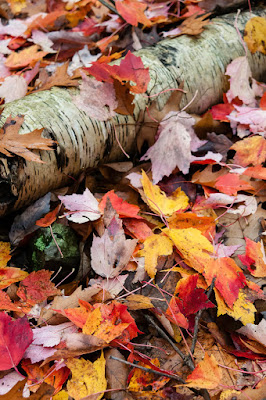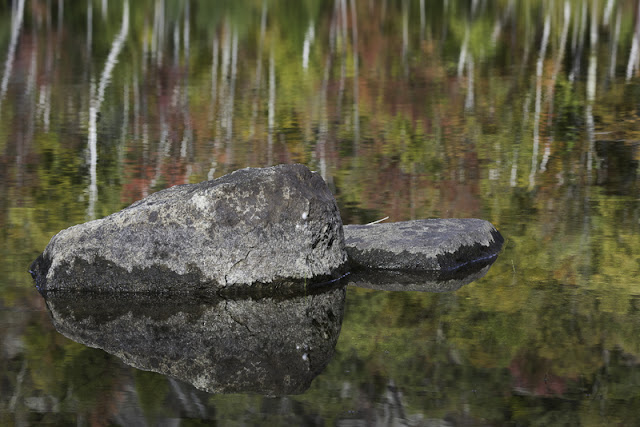On a recent trip to Adirondack Mountains, I never drove past this barn without seeing one to three cars stopped to photograph it. It is dull. Our brain sees the distant colors and cancels out the dull reds of the barn and the fading grasslands. Only a small portion of the photo really has colorful trees. But, that dull red barn is the introduction to the story our photo is telling. Do you read a book with a dull first chapter? Not often.
So, I am going to share some ideas for transforming your autumn photos from average to very interesting. First, you should be able to describe what a photo is saying in one sentence. This photo said to me:
It was worth the half-mile hike on a cool fall morning to see the rich colors at Round Pond.
It has some interesting shoreline in the foreground to lead the viewer toward the colorful trees, and then to the deep blue sky with wisp colds. As a bonus, the trees and sky are doubled up as reflections on the mirror-like water. Compare it to the first photo that has only mediocre foreground, modest color and a modest blue sky with no clouds to add interest. Here are the first two concepts to make better fall photos:
- Put something of interest in the foreground.
- Only show the sky if it is interesting.
This image also introduces a third concept:
- Use selective focus to identify the photo's subject and control where the viewer enters the scene.
 Selective focus goes in hand with another key concept.
Selective focus goes in hand with another key concept. - Make a range of shots just like the movies where they have eight different shots defined.
While I did travel to the Adirondacks for the first two images, it is not necessary to make a long drive. The maple leaf photo at left was on a nature trail only a few miles from my home. Also, you do not need to have the so-called peak colors to capture autumn. This photo was made past peak, when I looked as much on the ground as into the tree tops.
This brings me to another idea for really seeing all that autumn can offer for photography. It is not just about colorful trees. There is much more that is happening. On yet another walk near home, I traveled an abandoned farm road looking for migrating birds. I saw none, but a wandering eye saw the milkweed in the process of casting its wispy seeds into the wind. This, too, is the season.
So often there is just too much going on, both in our daily lives and in the photos that we make. That introduces another concept for both:
- Tell a story.
Another concept is about keeping your photos real.
- Keep the colors real. Don't overdo the colors.
 Finally, I offer a word on weather.
Finally, I offer a word on weather.- Love damp, rainy days.
I appreciate your interest and hope these concepts make for special fall memories in your photo collection.







No comments:
Post a Comment